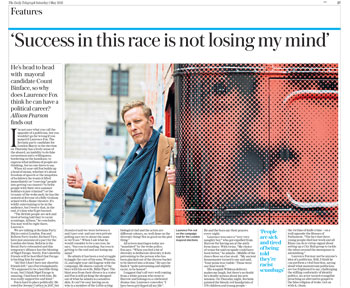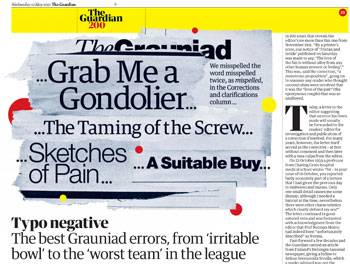
When obituaries only tell half the story
The biggest and most telling decisions facing anyone putting together a newspaper are not what to print – real stories tend to select themselves – but what to leave out. As one editor told me years ago, you don’t have to justify publishing a legitimate story, but there needs to be a very good reason not to.
His concern was about vested interests trying to influence content and keep unfavourable information from public view. Very laudable, although his strictures were not helpful to a chief sub with 50 stories in the in-tray and at most 30 slots to accommodate them. I was bound to get it wrong, and frequently did.
The same publish-or-omit decisions recur down the line when it comes to the stories you have actually decided to run. Which facts or quotes are dispensable? I would suggest that if the subject of an obituary had killed his first wife, that fact should be essential to the report.
This week, The Sun mourned its former chief reporter John Kay, and gave him a glowing send-off in a double-page spread paying tribute to the “king of scoops”. It listed his many achievements and carried tributes from fellow journalists. But it completely neglected to mention that in 1977, he had strangled and drowned his wife Harue. Newspaper reports of his trial show that the prosecution accepted that Kay, then 34, had suffered a breakdown at the prospect of taking on a new role that daunted him and that he had tried to kill himself. His plea of guilty to manslaughter on the ground of diminished responsibility was accepted, he was committed to hospital and subsequently returned to the paper, which had paid for his defence and promised there would be a job for him once he was fit again.
This tragic episode must have had an enormous bearing on Kay’s future outlook on life, and the paper’s behaviour in standing by their man was commendable. To leave it out of its coverage was shoddy – a woman lost her life, remember, and there is no question that the fact would have been at or near the top of any other obit. But it was also an opportunity squandered. Here was someone who had overcome extreme mental health problems to carve out an exceptionally successful career.
The Sun has a poor record on the coverage of mental health issues – look at the way it treated Frank Bruno and its “Madman in the cockpit” splash six years ago when Andreas Lubitz deliberately crashed a Germanwings Airbus, killing 150 people – but it has been showing greater sensitivity of late. It should have grasped this nettle firmly and shown how people can rise from their lowest point and recover self-belief and pride after shame.
But instead, the paper took an airbrush to history.
Here was someone who had overcome extreme mental health problems to carve out an exceptionally successful career.
Publicity boost

Timing is everything. Last year, Laurence Fox made a lot of friends and enemies with an appearance on Question Time in which he accused an audience member of colour of being racist. Seemingly emboldened by the reaction, he started posting ever more controversial tweets against “wokeism” and lockdown, set himself up with a political party and decided to run for London mayor.
Given his thespian lineage, his popularity as James Hathaway in the TV detective series Lewis, and the fact that he was once married to Billie Piper, there is an undoubted public interest in his antics. Last December, The Times sent Andrew Billen to interview him and ran the resultant copy across five pages of its Saturday magazine. It was a thoroughly well-rounded piece, posing challenging questions, allowing Fox to condemn himself or convince others out of his own mouth.
Last month, Fox was quizzed again. This time by Allison Pearson of the Telegraph. Her take, which also appeared on a Saturday, was more light-hearted and more sympathetic – Pearson has been a strident voice against lockdown – but generally unexceptionable.
On the same day, the Guardian ran a piece about 23-year-old Niko Omilana, a prankster with 3.4m YouTube followers who said he was standing as a joke. Neither Fox nor Omilana had a hope of winning, but both had hopes of publicity. And the Telegraph and Guardian obliged.
Throughout the campaign, the nationals naturally focused on the Labour incumbent Sadiq Khan and his Tory rival Shaun Bailey. When it came to the fringe candidates, we’d seen Count Binface before, so you can’t blame the Telegraph and Guardian for going for the two most famous also-rans in a field of 20. But it feels uncomfortable when the LibDems and Greens didn’t get a look in anywhere.
The problem was not in giving a platform to two men who had neither the desire nor hope of winning, but in doing so on the Saturday before polling day.
It feels uncomfortable when the LibDems and Greens didn’t get a look in anywhere.
The Queen’s Speech: asking the right questions

Congratulations to the Daily Mail for taking the Government to task over the absence from the Queen’s Speech of any social care reform.
Too many journalists – print and broadcast – are spending too much time taking dictation from our rulers and too little time challenging, or at least questioning, them.
There is an argument that with an 80-odd majority, nothing can stop the Government doing what it wants and so it is a reader service to spell out exactly what it’s planning. That seems to have been what happened yesterday at the Times (university cancel culture) and Telegraph (social media). The Times splash had a sentence of criticism from the universities; the Telegraph no word of dissent and a separate column from the minister involved.
The Express ran true to form, promising that everything would be wonderful under Boris, while the Guardian was equally predictably hostile, raising concerns about plans to require ID from voters. And so it was the Mail that deserved plaudits for setting party loyalty aside and putting its readers’ interests first (albeit with a bit of self-aggrandisement in the process).
Too many journalists are spending too much time taking dictation from our rulers and too little time challenging them.
Celebrating 200

Happy 200th birthday to the Grauniad, which has been celebrating with tributes from men and women in high places and a “200 years, 200 pieces” online reminder of what it modestly describes as its “most memorable journalism of all time”. These are ranged under 14 headings and so far we’ve had investigations, environment, women, international and injustice. Today sport gets its turn.
For lightweights like me, the Guardian’s most memorable effort was the San Serriffe supplement of April 1, 1977 – which to my mind pips Panorama’s spaghetti harvest from 20 years earlier as the best April fool of all time – and I do hope they reproduce it. I suspect, however, that it is more proud of its coverage of the abolition of slavery and the Windrush scandal.
Still, it’s not all po-faced do-goodery – in print at least. On Monday, Rupert Neate documented the rudest things people had said about the paper, and yesterday brought a feature by Elisabeth Ribbans on the typos that earned the paper its nickname. They included this priceless correction from 2007: “We misspelled the word misspelled twice, as mispelled, in the Corrections and clarifications column on September 26.”
At least it managed not to render her byline Elizabeth Ribbons.
For lightweights like me, the Guardian’s most memorable effort was the San Serriffe supplement of April 1, 1977.
Liz Gerard’s Notebook is a fortnightly column published in the InPubWeekly newsletter. To be added to the mailing list, enter your email address here.












